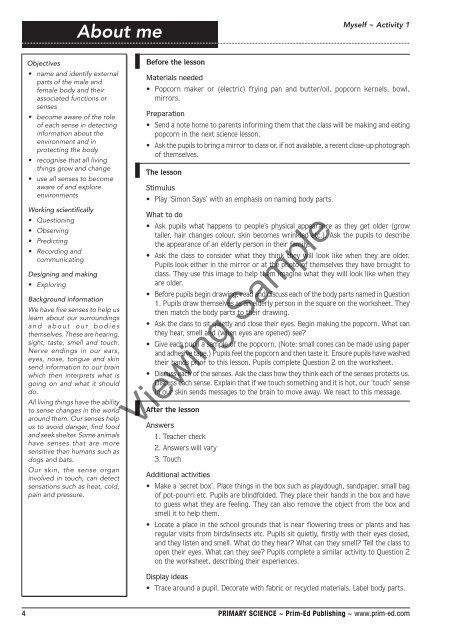PR-0552UK Primary Science - Book 2
Create successful ePaper yourself
Turn your PDF publications into a flip-book with our unique Google optimized e-Paper software.
About me<br />
Myself ~ Activity 1<br />
Objectives<br />
• name and identify external<br />
parts of the male and<br />
female body and their<br />
associated functions or<br />
senses<br />
• become aware of the role<br />
of each sense in detecting<br />
information about the<br />
environment and in<br />
protecting the body<br />
• recognise that all living<br />
things grow and change<br />
• use all senses to become<br />
aware of and explore<br />
environments<br />
Working scientifically<br />
• Questioning<br />
• Observing<br />
• Predicting<br />
• Recording and<br />
communicating<br />
Designing and making<br />
• Exploring<br />
Background information<br />
We have five senses to help us<br />
learn about our surroundings<br />
a n d a b o u t o u r b o d i e s<br />
themselves. These are hearing,<br />
sight, taste, smell and touch.<br />
Nerve endings in our ears,<br />
eyes, nose, tongue and skin<br />
send information to our brain<br />
which then interprets what is<br />
going on and what it should<br />
do.<br />
All living things have the ability<br />
to sense changes in the world<br />
around them. Our senses help<br />
us to avoid danger, find food<br />
and seek shelter. Some animals<br />
have senses that are more<br />
sensitive than humans such as<br />
dogs and bats.<br />
Our skin, the sense organ<br />
involved in touch, can detect<br />
sensations such as heat, cold,<br />
pain and pressure.<br />
Before the lesson<br />
Materials needed<br />
• Popcorn maker or (electric) frying pan and butter/oil, popcorn kernels, bowl,<br />
mirrors.<br />
Preparation<br />
• Send a note home to parents informing them that the class will be making and eating<br />
popcorn in the next science lesson.<br />
• Ask the pupils to bring a mirror to class or, if not available, a recent close-up photograph<br />
of themselves.<br />
The lesson<br />
Stimulus<br />
• Play ‘Simon Says’ with an emphasis on naming body parts.<br />
What to do<br />
• Ask pupils what happens to people’s physical appearance as they get older (grow<br />
taller, hair changes colour, skin becomes wrinkled etc.). Ask the pupils to describe<br />
the appearance of an elderly person in their family.<br />
• Ask the class to consider what they think they will look like when they are older.<br />
Pupils look either in the mirror or at the photo of themselves they have brought to<br />
class. They use this image to help them imagine what they will look like when they<br />
are older.<br />
• Before pupils begin drawing, read and discuss each of the body parts named in Question<br />
1. Pupils draw themselves as an elderly person in the square on the worksheet. They<br />
then match the body parts to their drawing.<br />
• Ask the class to sit quietly and close their eyes. Begin making the popcorn. What can<br />
they hear, smell and (when eyes are opened) see?<br />
• Give each pupil a sample of the popcorn. (Note: small cones can be made using paper<br />
and adhesive tape.) Pupils feel the popcorn and then taste it. Ensure pupils have washed<br />
their hands prior to this lesson. Pupils complete Question 2 on the worksheet.<br />
• Discuss each of the senses. Ask the class how they think each of the senses protects us.<br />
Discuss each sense. Explain that if we touch something and it is hot, our ‘touch’ sense<br />
in our skin sends messages to the brain to move away. We react to this message.<br />
Viewing Sample<br />
After the lesson<br />
Answers<br />
1. Teacher check<br />
2. Answers will vary<br />
3. Touch<br />
Additional activities<br />
• Make a ‘secret box’. Place things in the box such as playdough, sandpaper, small bag<br />
of pot-pourri etc. Pupils are blindfolded. They place their hands in the box and have<br />
to guess what they are feeling. They can also remove the object from the box and<br />
smell it to help them.<br />
• Locate a place in the school grounds that is near flowering trees or plants and has<br />
regular visits from birds/insects etc. Pupils sit quietly, firstly with their eyes closed,<br />
and they listen and smell. What do they hear? What can they smell? Tell the class to<br />
open their eyes. What can they see? Pupils complete a similar activity to Question 2<br />
on the worksheet, describing their experiences.<br />
Display ideas<br />
• Trace around a pupil. Decorate with fabric or recycled materials. Label body parts.<br />
4 <strong>PR</strong>IMARY SCIENCE ~ Prim-Ed Publishing ~ www.prim-ed.com


















